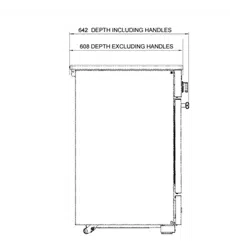Loading ...
Loading ...
Loading ...

5
Induction and ceramic care
• IMPORTANT INFORMATION FOR
PACEMAKER AND IMPLANTED INSULIN
PUMP USERS: The functions of this hob
comply with the applicable European
standards on electromagnetic interference.
If you are fitted with a pacemaker or
implanted insulin pump and are concerned
please consult your doctor for medical
advice.
• When the hob is in use keep magnetic
items away, such as credit and debit cards,
floppy disk, calculators, etc.
• To fully utilise the power of your
induction hob and to ensure longevity
of performance, we recommend the use
of AGA Rangemaster Induction Pots
and Pans. If you decide to purchase an
alternative set of pans for use on your
induction cooker, we would strongly
recommend that composite aluminium
pans with steel inserts, example shown
Fig. 1.3, are avoided. This type of pan
construction can significantly reduce
the lifetime and performance of your
induction cook top.
• Take care when touching the marked
cooking areas of the hob.
• Use adequately sized pans with flat
bottoms that are large enough to cover the
surface of the hotplate heating area. Using
undersized pans will expose a portion of
the hotplate surface to direct contact and
may result in the ignition of clothing
• Only certain types of glass, glass-ceramic,
earthenware or other glazed containers
are suitable for use on the warming zone;
others may break because of the sudden
change in temperature.
• Only certain types stainless steel,
enamelled steel pans or cast iron pans with
enamelled bases are suitable for induction
hob cooking.
• Take care NOT to scratch the surface when
placing cookware on the glass panel.
• Only certain types of glass, glass-ceramic,
earthenware or other glazed containers are
suitable for hotplate cooking; others may
break because of the sudden change in
temperature. NEVER cook directly on the
hob surface (Fig. 1.4).
• DO NOT leave the hob zones switched on
unless being used for cooking.
• DO NOT stand or rest heavy objects on the
hob. Although the ceramic surface is very
strong, a sharp blow or sharp falling object
(e.g. a salt cellar) might cause the surface
to crack or break (Fig. 1.5).
n
WARNING: Should a crack appear in
the surface, disconnect the appliance
immediately from the supply and
arrange for its repair.
• Always LIFT pans off the hob. Sliding pans
may cause marks and scratches (Fig. 1.6).
• Take care NOT TO PLACE HOT LIDS onto
the Hob surface (Fig. 1.7). Lids that have
been used to cover a hot pan can “stick”
or create a “vacuum” effect to the Glass
Hob. Should this occur, DO NOT attempt
to lift the lid off the glass surface, this may
damage the glass. Instead slide the lid to
the edge of the hob surface and remove,
taking care not to scratch the hob surface.
Alternatively wait until the lid has cooled to
room temperature, the vacuum has been
released, then remove the lid by lifting it
from the hob surface.
• DO NOT place anything between the
base of the pan and the hob surface (e.g.
asbestos mats, aluminium foil, wok stand).
• Take care NOT to place metallic objects
such as knives, forks, spoons and lids on
the hob surface since they can get hot.
Loading ...
Loading ...
Loading ...
